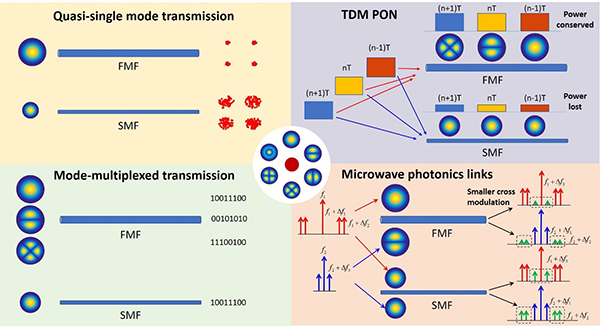As the transmission capacity worldwide continues to grow exponentially and single-mode fiber-optic communication systems approach their capacity limit, space-division multiplexing (SDM) has attracted significant attention in recent years. By employing multiple spatial modes in few-mode fibers (FMFs) or multiple cores in multicore fibers, SDM provides a larger transmission capacity and enhanced signal processing ability compared with single mode fibers (SMFs).
However, there are unavoidable defects due to limited fabrication accuracy such as index profile fluctuation, geometry deviation, and microbending in practical fibers as well as environment changes, leading to crosstalk among fiber modes. Digital signal processing (DSP), required to recover independent information despite mode crosstalk, increases system complexity and cost.
Weakly-coupled FMFs offer a cost-effective alternative since DSP is not needed anymore at the receiver. This benefits not only mode-division multiplexing (MDM), but also many other applications, due to more degrees of freedom (DOFs).
In the article "Applications of weakly-coupled few-mode fibers" published in Chinese Optics Letters, Vol. 18, Issue 4, 2020 (Huiyuan Liu, He Wen, Guifang Li. Applications of weakly-coupled few-mode fibers [Invited][J]. Chinese Optics Letters, 2020, 18(4): 040601), the authors demonstrate several application scenarios of weakly-coupled FMFs, with only deployment of spatial DOFs or combined with other DOFs.
First, the relationship between effective area of the fundamental mode and the effective index difference between the first two modes is studied to understand the tradeoff between the reductions of nonlinear effects and linear modal crosstalk.
Second, quasi-single-mode transmission in weakly-coupled FMFs is demonstrated using only one element of spatial DOFs (one mode), with weaker nonlinear effects due to larger effective area. Larger power can be launched to increase the transmission distance.
Third, DSP-free mode-group-multiplexed transmission in weakly-coupled FMFs is demonstrated for increased fiber capacity, using multiple elements of spatial DOFs (multiple modes). Stable 3×10 Gb/s transmission over 20 km FMF is demonstrated experimentally.
To effectively deliver signal in each spatial mode channel, a photonic lantern as a low-crosstalk mode multiplexer is also needed in the transmission system. Assisted by spatial DOFs, performance improvement is demonstrated in the systems using other DOFs of light such as time and wavelength. The combining loss of upstream transmission in TDM PON system is eliminated by replacing SMFs with FMFs. Last but not least, nonlinearities in WDM microwave transmission links are alleviated assisted by using spatial modes, due to spatial orthogonality and phase walk-off between spatial modes.
"The space dimension extends both the signal space and the space in which we transmit, process, generate and detect information. The weakly-coupled few-mode fibers paves the way to the extended space." says Dr. He Wen, working in the Optical Fiber Communication group in Center for Research and Education in Optics and Lasers (CREOL), the College of Optics and Photonics at the University of Central Florida.
Currently, weakly-coupled FMFs can achieve very low crosstalk better than mode multiplexers. Future work will focus on developing mode multiplexers with better mode selectivity and lower loss to further improve system performance.

Advantage demonstration of weakly-coupled FMF compared with SMF in different applications.


